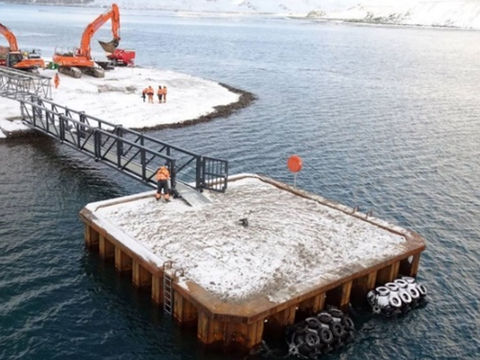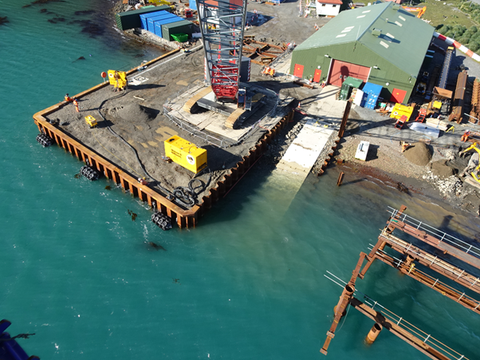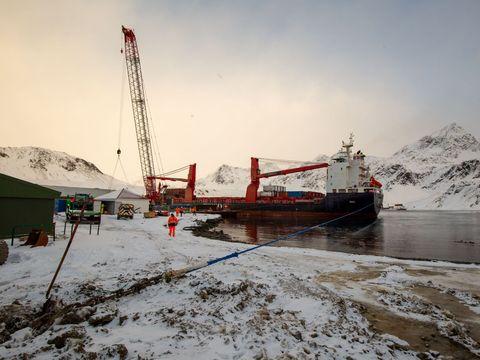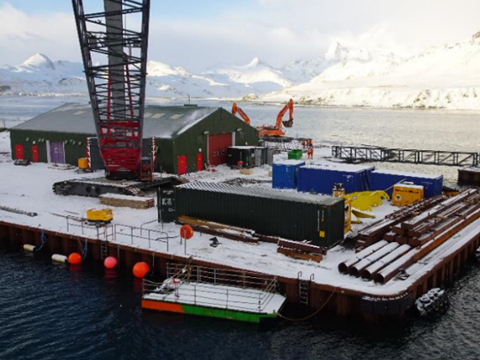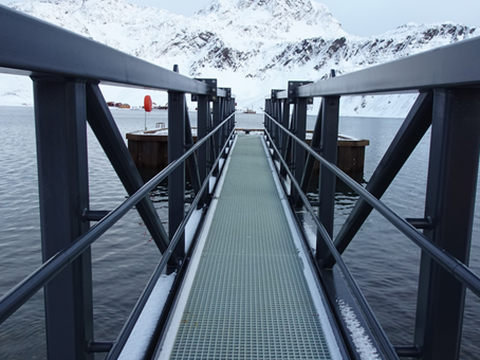Quay wall King Edward Point, King Edward Point, South Georgia
The Antarctic Infrastructure Modernisation Programme commissioned by the Natural Environment Research Council will enable a world-leading capability to ensure that Britain remains at the forefront of climate, biodiversity and oceanographic research in Polar regions. Through the programme, British Antarctic Survey (BAS) is enhancing station facilities. The upgrade of the wharf at King Edward Point in the Sub-Antarctic region will allow the new and highly advanced polar research vessel RRS Sir David Attenborough to berth.
The old wharf at King Edward Point was at the end of its design life and did not provide sufficient draft and length to accomodate the RSS Sir David Attenborough. The new wharf, designed for a 50 year service life, consists of a main loading platform (ca. 28m long x 30m wide) which is constructed as a wrap around the old wharf sheet pile structure to achieve a water depth at the fender line of at least 8m. This concept keeps the wharf at its original location which reduces the possible impact to the environment. Furthermore it avoids the dismantling of the old structure and limits the amount of additional local backfill required. With protected flora and wildlife, minimum environmental impact is a key aspect to the King Edward Point project.
The structural concepts of the new wharf are strongly driven by the remoteness of the project location. All materials and equipment are transported in a single shipment and selected on the basis of low local maintenance. Next to that, the construction window is limited to the six months of the Austral summer. Construction time on site has been limited by prefabrication of the steel structures and concrete elements which also provides the environmental, bio security and programme benefits over on site construction/manufacture.
A longer berthing face is created with an 11m square standalone cofferdam structure tied with a top inner frame. For an optimized footprint, this structure has been modelled with advanced 3D geotechnical software which takes account of the sidewise load transfer in the soil and contribution of the side walls. Access to the dolphin is enabled via a 22m long steel truss bridge. A new slipway replacing the old one, allows the retreival of the small boats.
The structures have been completed with a main fendering system composed of foam filled fenders and tee-head bollards. Additional mooring points for the head and stern lines of the ships consist of large embedment anchors on-shore and one drag anchor on the seabed which is connnected to a floating buoy.
DMC developed the Target Cost Design (input for risk assessment and work methods, DMA, scour assessment), the Detailed Design for the wharf structures and provided technical input for the Operations & Maintenance manual. Furthermore DMC provided back-office site engineering support during construction.
Facts and Figures
Location
South Georgia
Structure
Wharf
Owner/Operator
Owner: Government of South Georgia and the South Sandwich Islands (GSGSSI) / Operator: British Antarctic Survey (BAS)
Our client
BAM International & BAM Nuttall
Completion design
2020
Challenge
In order to accommodate the new research ship Sir David Attenborough a longer and deeper berth was required. This in an extremelly remote location (5 day sail from nearest airfield), limited availability of materials and strict environmental requirements
Solution
Design of a new wharf around the existing one which minimizes the material requirements and an additional dolphin optimized with 3D Plaxis. The limiting operational conditions were determined in close colaboration with the operator and the ships' masters.


